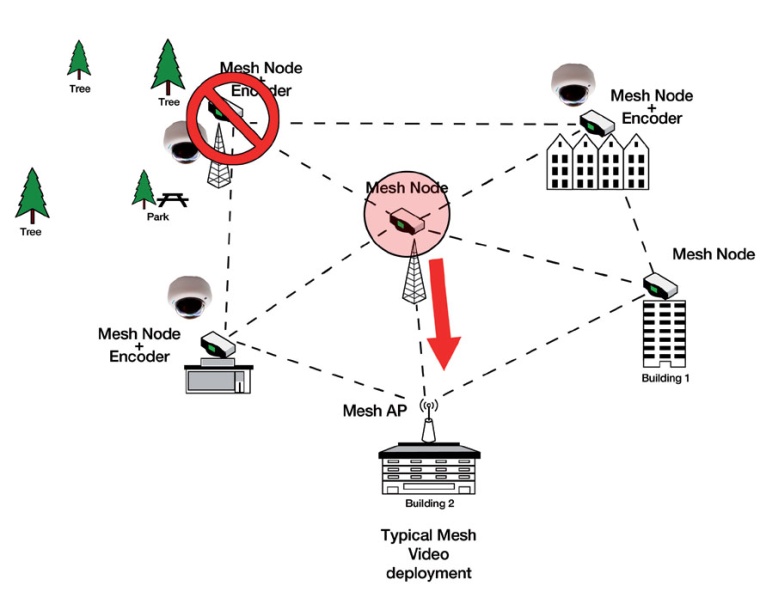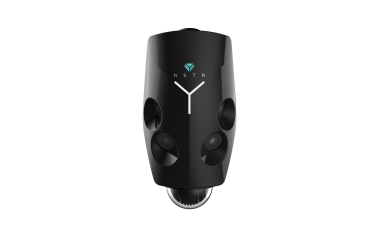Verint Systems: is Mesh the right technology for CCTV applications?
Verint Systems: is Mesh the right technology for CCTV applications? To mesh or not to mesh? That is the question. Or at least that is the question currently being posed by integrat...




Verint Systems: is Mesh the right technology for CCTV applications? To mesh or not to mesh? That is the question. Or at least that is the question currently being posed by integrators looking to get the best out of today’s wireless video solutions. The answer is not as easy as you’d imagine. In simple terms, a wireless mesh network extends the capabilities of an existing data network using radio technology. Ethernet is by far the most widely deployed data networking technology, so it’s considered desirable to develop wireless mesh technology that builds on Ethernet.
At the heart of a modern wired Ethernet network is an Ethernet switch, where every user of the network is plugged into one connector on the switch. Switches are then ganged together to support what could be many thousands of users. Wireless mesh networks in effect function in exactly the same way.
Ethernet packets arrive at any port on the mesh and are delivered to the destination port across the mesh backbone. A single mesh is the collection of nodes that share a common database of packet routing information. Nodes within a mesh share information (in real time) about the number and capacity of all links in the mesh, and use this information to deliver packets.
Outdoor Applications
Wireless Ethernet meshes are useful in a number of applications, but especially outdoor applications where the installation of Ethernet cables is impractical: they can be of use in Access Point Support for VoIP, for example, to give better coverage for cordless VoIP phones. They can provide a good way to support general data applications, either via wired Ethernet connections or via AP deployments. Uses include in-room Internet at hotels, building-to-building links in campuses and office parks, 802.11 coverage for credit card readers and point-of-sale (POS) devices, and other similar applications.
They are also of use within transport applications, for example to help the police and fire vehicles to remain in contact whilst in pursuit of their duties, and can also be used to provide Internet access to passengers on buses or trains. And there are other applications: with many cities deploying Wi-Fi networks for public use, mesh networks are proving a useful solution.
Each of these different mesh applications will have different design goals and requirements, but in many cases, a mesh may be built with more than one of these applications in mind. One of the most hotly debated uses for Mesh networks is in security, and specifically video surveillance, a bandwidth intensive and delay constrained application.
Mobile Video Solution
A recent example helps illustrate the point. A major metro police department needed video surveillance in a hurry to help catch a killer – or two as it turned out. Working with an experienced system integrator, they deployed over 20 IP cameras in two weeks, utilising a wireless mesh to deliver the video back to police headquarters. The mesh chosen operated in the 4.9 GHz spectrum reserved in the US for public safety to minimise interference from, and with, other wireless services. The mesh network connected to the city’s fibre network for backhaul to police headquarters, where typically two officers staffed the monitoring room.
The initial deployment consisted of 30 cameras and 45 mesh nodes, grouped into seven interconnected mesh networks, and covering 40 square miles. The police department used custom- developed “camera hides” to ensure the surveillance was covert. The area being covered included some new 40-storey high rise apartments making it difficult RF territory.
The ease with which both the cameras and nodes could be moved was therefore very important. Once a mesh was up and running, individual nodes could be moved at will within the overall mesh area without requiring any reconfiguration. Two neighbourhoods were identified for initial deployment, and locations with access to the City’s fibre backbone were chosen. From these anchor points, a grid was developed, with nodes sited on utility poles in most locations. Not all nodes had cameras, but camera sites were selected based on police data of problem areas.
By slightly overbuilding the mesh, the police had the ability to deploy temporary additional cameras at will. A bandwidth analysis was also performed, from which it was determined that at least four connections would be needed from the mesh to the wired infrastructure in order to assure quality video. Working out from the backbone connection points, nodes were mounted and brought online.
The net result of all this work was a successful operation. The use of video surveillance allowed more officers to be deployed on investigations, and the killers were eventually caught and convicted.
Strengths and Weaknesses
The example given is of a mobile surveillance application where the use of a wireless Mesh particularly comes into its own. But does that mean that wireless Mesh is suited to all video surveillance applications? The answer appears to be “no”, and for very good reasons. The principal weakness of Mesh is that the bandwidth of the total network is limited by the weakest link within that network.
Put another way, the network will only operate at the rate of its weakest link. Mesh also tends not to be efficient in applying constant rate. Put less technically, Mesh tends to “chop up” the traffic which in turns slows down the wireless transmission, causing considerable issues, such as latency and jitter in video applications. Since video is a high bandwidth application, sparse mesh network, similar to a standard Wi-Fi solution, is usually recommended reducing the mesh capabilities.
Typical Mesh Video Deployment and Node Failure Case
Reliability is therefore a major concern. If a customer wants a high-end video solution, he needs to know that there won’t be signal delays over the network – an issue known as “latency”. Mesh networks, however, suffer considerably from latency, sometimes causing delays of up to five seconds which renders the use of PTZ cameras, for example, as virtually impossible, and restricting it to low resolution video applications with static cameras only. Mesh does have the advantage in niche video applications such as mobile deployment.
If you are monitoring one part of the city one day using a mesh infrastructure and moving the systems in another part of the city the next week, as was proven in the police case study, the network does not have to be constantly reconfigured.
A Mesh Alternative
For high-end video security applications, however, there are better, more reliable solutions. For instance, Verint’s Nextiva wireless 5.1, has considerably more capacity and a greater range than “typical” wireless devices, with an improved bandwidth of up to 28Mbps. This means that the quality of video is improved, bandwidth is maximised, and the number of transmitters per access point can be increased (up to 24 cameras). The net result is a lower cost of ownership and higher reliability for the complete wireless video solution.
Typical Verint Wireless Video Deployment
Verint’s S4300 Series Redundant Master Setup is also a direct alternative to Mesh for security applications, but tends to be considerably more robust. It enables customers to configure their Wireless system, when SPCF unique protocol is used, such that a master S4300 takes over when a nearby master fails (for example through power or wireless failure).
A ‘Failover’ mechanism works for S4300 master devices in any type of application (access points, wireless bridges and, repeaters). Nextiva wireless solutions are also more robust in that they can withstand temperatures from –30 °C to +50 °C (-22F to 122F). Many mesh solutions require a NEMA enclosure for use with an encoder and a heater. Line of sight allows for robust wireless links and greater distances between wireless video links.
The S4300 repeater solution is available to circumvent obstacles if line of sight is not available. In general, mesh networks are good at combating line-of-sight issues; however, the use of intermediary nodes on mesh networks can slow down video transmission. All wireless networks are subject to the laws of physics and may encounter some line-of-sight issues. Mesh networks have their place.
They can be useful in niche video applications such as the mobile CCTV equipment or for static applications where you don’t need a high quality image – or where you can place video for a specific reason onto a broader existing network. But if you want high end video and use PTZ cameras and fast response to event, Mesh is not the right technology, because of the latency, because of the weakest link, and because the technology is not tailored specifically for video.
Contact:
Robert Wint
Verint Systems UK Ltd,
Weybridge, United Kingdom
Tel.: +44 1932 839 500
Fax: +44 1932 839 501
marketing.emea@verint.com
www.verint.com
most read

The Benefits of AI-based Video Surveillance Solutions for Sports Venues
Dallmeier Interview: Artificial intelligence Makes Stadiums Smarter

Is Your Venue Ready for Martyn’s Law?
Martyn’s Law demands stronger security by 2027. Is your venue prepared to protect and respond?

GIT SECURITY AWARD 2026 - The winners have been announced!
GIT SECURITY AWARD 2026: The best safety and security solutions of the year - now an overview of all winners

Machine & plant safety: The winners of category A at the GIT SECURITY AWARD 2026
GIT SECURITY AWARD 2026: Machine & plant safety - an overview of the most innovative solutions

Video security & video management: the winners of category C at the GIT SECURITY AWARD 2026
GIT SECURITY AWARD 2026: Video Security & Video Management - an overview of the most innovative solutions








